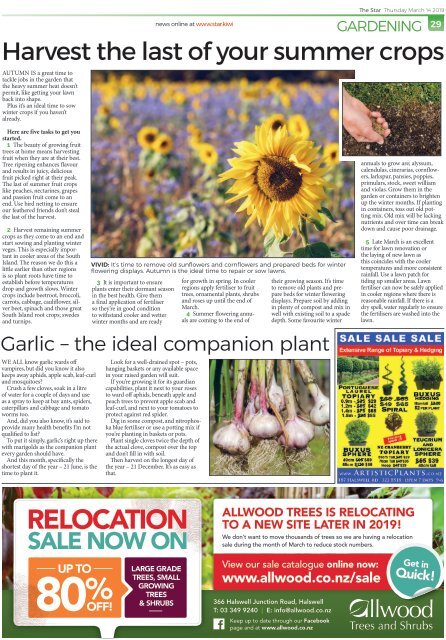The Star: March 14, 2019
You also want an ePaper? Increase the reach of your titles
YUMPU automatically turns print PDFs into web optimized ePapers that Google loves.
news online at www.star.kiwi<br />
<strong>The</strong> <strong>Star</strong> Thursday <strong>March</strong> <strong>14</strong> <strong>2019</strong><br />
GARDENING 29<br />
Harvest the last of your summer crops<br />
AUTUMN IS a great time to<br />
tackle jobs in the garden that<br />
the heavy summer heat doesn’t<br />
permit, like getting your lawn<br />
back into shape.<br />
Plus it’s an ideal time to sow<br />
winter crops if you haven’t<br />
already.<br />
Here are five tasks to get you<br />
started.<br />
1 <strong>The</strong> beauty of growing fruit<br />
trees at home means harvesting<br />
fruit when they are at their best.<br />
Tree ripening enhances flavour<br />
and results in juicy, delicious<br />
fruit picked right at their peak.<br />
<strong>The</strong> last of summer fruit crops<br />
like peaches, nectarines, grapes<br />
and passion fruit come to an<br />
end. Use bird netting to ensure<br />
our feathered friends don’t steal<br />
the last of the harvest.<br />
2 Harvest remaining summer<br />
crops as they come to an end and<br />
start sowing and planting winter<br />
veges. This is especially important<br />
in cooler areas of the South<br />
Island. <strong>The</strong> reason we do this a<br />
little earlier than other regions<br />
is so plant roots have time to<br />
establish before temperatures<br />
drop and growth slows. Winter<br />
crops include beetroot, broccoli,<br />
carrots, cabbage, cauliflower, silver<br />
beet, spinach and those great<br />
South Island root crops; swedes<br />
and turnips.<br />
WE ALL know garlic wards off<br />
vampires, but did you know it also<br />
keeps away aphids, apple scab, leaf-curl<br />
and mosquitoes?<br />
Crush a few cloves, soak in a litre<br />
of water for a couple of days and use<br />
as a spray to keep at bay ants, spiders,<br />
caterpillars and cabbage and tomato<br />
worms too.<br />
And, did you also know, it’s said to<br />
provide many health benefits I’m not<br />
qualified to list?<br />
To put it simply, garlic’s right up there<br />
with marigolds as the companion plant<br />
every garden should have.<br />
And this month, specifically the<br />
shortest day of the year – 21 June, is the<br />
time to plant it.<br />
VIVID: It’s time to remove old sunflowers and cornflowers and prepared beds for winter<br />
flowering displays. Autumn is the ideal time to repair or sow lawns.<br />
3 It is important to ensure<br />
plants enter their dormant season<br />
in the best health. Give them<br />
a final application of fertiliser<br />
so they’re in good condition<br />
to withstand cooler and wetter<br />
winter months and are ready<br />
Look for a well-drained spot – pots,<br />
hanging baskets or any available space<br />
in your raised garden will suit.<br />
If you’re growing it for its guardian<br />
capabilities, plant it next to your roses<br />
to ward off aphids, beneath apple and<br />
peach trees to prevent apple scab and<br />
leaf-curl, and next to your tomatoes to<br />
protect against red spider.<br />
Dig in some compost, and nitrophoska<br />
blue fertiliser or use a potting mix if<br />
you’re planting in baskets or pots.<br />
Plant single cloves twice the depth of<br />
the actual clove, compost over the top<br />
and don’t fill in with soil.<br />
<strong>The</strong>n harvest on the longest day of<br />
the year – 21 December. It’s as easy as<br />
that.<br />
for growth in spring. In cooler<br />
regions apply fertiliser to fruit<br />
trees, ornamental plants, shrubs<br />
and roses up until the end of<br />
<strong>March</strong>.<br />
4 Summer flowering annuals<br />
are coming to the end of<br />
their growing season. It’s time<br />
to remove old plants and prepare<br />
beds for winter flowering<br />
displays. Prepare soil by adding<br />
in plenty of compost and mix in<br />
well with existing soil to a spade<br />
depth. Some favourite winter<br />
Garlic – the ideal companion plant<br />
annuals to grow are; alyssum,<br />
calendulas, cinerarias, cornflowers,<br />
larkspur, pansies, poppies,<br />
primulars, stock, sweet william<br />
and violas. Grow them in the<br />
garden or containers to brighten<br />
up the winter months. If planting<br />
in containers, toss out old potting<br />
mix. Old mix will be lacking<br />
nutrients and over time can break<br />
down and cause poor drainage.<br />
5 Late <strong>March</strong> is an excellent<br />
time for lawn renovation or<br />
the laying of new lawn as<br />
this coincides with the cooler<br />
temperatures and more consistent<br />
rainfall. Use a lawn patch for<br />
tiding up smaller areas. Lawn<br />
fertiliser can now be safely applied<br />
in cooler regions where there is<br />
reasonable rainfall. If there is a<br />
dry spell, water regularly to ensure<br />
the fertilisers are washed into the<br />
lawn.<br />
relocATion<br />
sAle now on<br />
Allwood Trees is relocATing<br />
To A new siTe lATer in <strong>2019</strong>!<br />
We don’t want to move thousands of trees so we are having a relocation<br />
sale during the month of <strong>March</strong> to reduce stock numbers.<br />
UP To<br />
80 % oFF!<br />
lArge grAde<br />
Trees, sMAll<br />
growing<br />
Trees<br />
& sHrUBs<br />
View our sale catalogue online now:<br />
www.allwood.co.nz/sale<br />
366 Halswell Junction Road, Halswell<br />
T: 03 349 9240 | E: info@allwood.co.nz<br />
get in<br />
Quick!<br />
Keep up to date through our Facebook<br />
page and at www.allwood.co.nz


















